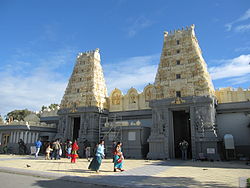 | |
 | |
| Total population | |
|---|---|
| Regions with significant populations | |
| Languages | |
| English, Hindi, Tamil, Malayalam, Telugu, Punjabi, Gujarati, Bengali, Fiji Hindi, Nepali, Mauritian Creole, Indian languages |
| Year | Pop. | ±% p.a. |
|---|---|---|
| 1911 | 414 | — |
| 1933 | 212 | −3.00% |
| 1986 | 21,500 | +9.11% |
| 1991 | 43,580 | +15.18% |
| 1996 | 67,270 | +9.07% |
| 2001 | 95,473 | +7.25% |
| 2006 | 148,123 | +9.18% |
| 2011 | 275,534 | +13.22% |
| 2016 | 440,300 | +9.83% |
| 2021 | 684,002 | +9.21% |
| Hinduism by country |
|---|
  |
| Full list |
Hinduism is the third largest religion in Australia consisting of more than 684,002 followers, making up 2.7% of the population as of the 2021 census. [2] Hinduism is the fastest growing religion in Australia mostly through immigration. [3] Hinduism is also one of the most youthful religions in Australia, with 34% and 66% of Hindus being under the age of 14 and 34, respectively. [4]
Contents
- History
- Demographics
- Hindu population by year
- Hindus by state or territory
- Hindu converts
- Languages
- Hindu temples in Australia
- Contemporary society
- Overseas territories
- Attacks on Hindu Community
- Image gallery
- See also
- References
- Sources
- External links
In the nineteenth century, the British first brought Hindus from India to Australia to work on cotton and sugar plantations. Many remained as small businessmen, working as camel drivers, merchants and hawkers, selling goods between small rural communities. Today, many Hindus are well educated professionals in fields such as medicine, engineering, commerce and information technology, constituting a model minority.[ citation needed ] The Hindus in Australia are mostly of Indian origin; other origins include those from Sri Lanka, Fiji, Malaysia, Bali, Cham, Singapore, Mauritius, and Nepal.







